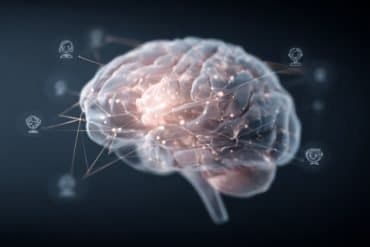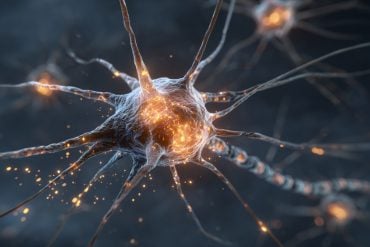Summary: Researchers have identified a pathway that leads to the phosphorylation of HDAC4, helping to promote sleep.
Source: University of Tsukuba
A good night’s sleep can work wonders for both mind and body. But what is it that determines how much we need to sleep, and what can cause us to sleep more deeply?
In a new study, researchers from the University of Tsukuba have now provided some answers, revealing a signaling pathway within brain cells that regulates the length and depth of sleep.
“We examined genetic mutations in mice and how these affect their patterns of sleep,” says senior author of the study, Professor Hiromasa Funato. “We identified a mutation that led to the mice sleeping much longer and more deeply than usual.” The researchers found that this was caused by low levels of an enzyme called histone deacetylase 4 (HDAC4), which is known to suppress the expression of target genes.
Previous studies on HDAC4 have shown that it is greatly affected by the attachment of phosphate molecules in a process known as phosphorylation. When this occurs, HDAC4 tends to move away from the cell nucleus, and the suppression of certain proteins is reduced. The researchers were interested in whether this phosphorylation of HDAC4 would affect sleep.
“We focused on a protein called salt-inducible kinase 3, otherwise known as SIK3, which phosphorylates HDAC4,” says Professor Funato. “We previously found that this protein has strong effects on sleep.”
The team found that when there was a lack of SIK3 or when HDAC4 was modified to prevent phosphorylation, the mice slept less. In contrast, when the mice had a more active version of SIK3, which increased the phosphorylation of HDAC4, they slept a lot more. They also identified a further protein, LKB1, which phosphorylates SIK3, and has similar sleep-suppressing effects when deficient.
“Our findings indicate that there is a signaling pathway within brain cells from LKB1 to SIK3 and then to HDAC4,” says study co-senior author, Professor Masashi Yanagisawa. “This pathway leads to the phosphorylation of HDAC4, which promotes sleep, most probably because it affects the expression of sleep-promoting genes.”

The team carried out further experiments to identify the brain cells in which these pathways regulate sleep. This involved altering the amounts of SIK3 and HDAC4 in different cell types and brain regions.
The results indicated that signaling within the cells of the cortex regulates the depth of sleep, while signaling within the hypothalamus regulates the amount of deep sleep. For both brain regions, the excitatory neurons, which can activate other neurons, were identified as playing a key role.
These results provide an important insight into how sleep is regulated, which could potentially lead to a greater understanding of sleep disorders as well as the development of new treatments.
Funding: This work was supported by the World Premier International Research Center Initiative from MEXT, JSPS KAKENHI, JST CREST, AMED, JSPS DC2, University of Tsukuba Basic Research Support Program Type A, Funding Program for World-Leading Innovative R&D on Science and Technology (FIRST Program).
About this sleep research news
Author: YAMASHINA Naoko
Source: University of Tsukuba
Contact: YAMASHINA Naoko – University of Tsukuba
Image: The image is in the public domain
Original Research: Closed access.
“Kinase signaling in excitatory neurons regulates sleep quantity and depth” by Hiromasa Funato et al. Nature
Abstract
Kinase signalling in excitatory neurons regulates sleep quantity and depth
Progress has been made in the elucidation of sleep and wakefulness regulation at the neurocircuit level. However, the intracellular signalling pathways that regulate sleep and the neuron groups in which these intracellular mechanisms work remain largely unknown.
Here, using a forward genetics approach in mice, we identify histone deacetylase 4 (HDAC4) as a sleep-regulating molecule.
Haploinsufficiency of Hdac4, a substrate of salt-inducible kinase 3 (SIK3), increased sleep. By contrast, mice that lacked SIK3 or its upstream kinase LKB1 in neurons or with a Hdac4S245A mutation that confers resistance to phosphorylation by SIK3 showed decreased sleep.
These findings indicate that LKB1–SIK3–HDAC4 constitute a signalling cascade that regulates sleep and wakefulness. We also performed targeted manipulation of SIK3 and HDAC4 in specific neurons and brain regions.
This showed that SIK3 signalling in excitatory neurons located in the cerebral cortex and the hypothalamus positively regulates EEG delta power during non-rapid eye movement sleep (NREMS) and NREMS amount, respectively.
A subset of transcripts biased towards synaptic functions was commonly regulated in cortical glutamatergic neurons through the expression of a gain-of-function allele of Sik3 and through sleep deprivation. These findings suggest that NREMS quantity and depth are regulated by distinct groups of excitatory neurons through common intracellular signals.
This study provides a basis for linking intracellular events and circuit-level mechanisms that control NREMS.







